Ed and I have just returned from an eye-opening three day trip to Chile discovering the wines of Viñedo Chadwick, Viña Errazuriz and Viña Seña in situ amongst the stunning South American scenery. Along with other key representatives of the UK fine wine trade, we were invited as guests of Eduardo Chadwick Claro, a charismatic and tireless visionary whose family have been making wine in Chile for over 140 years. His goal is to create internationally recognised fine wines of the highest quality from Chile’s unique terroirs.
For a New World wine region, Chile has a long viticultural history which dates back to the 16th Century when the Spanish conquistadores bought vines with them. In the mid-19th Century, French varieties were introduced and this, coupled with a large number of French families immigrating to Chile during the late 20th century, meant that Chile would look to France (rather than Spain) for its vinous inspiration. With this in mind, it was time to get on the plane and discover more.
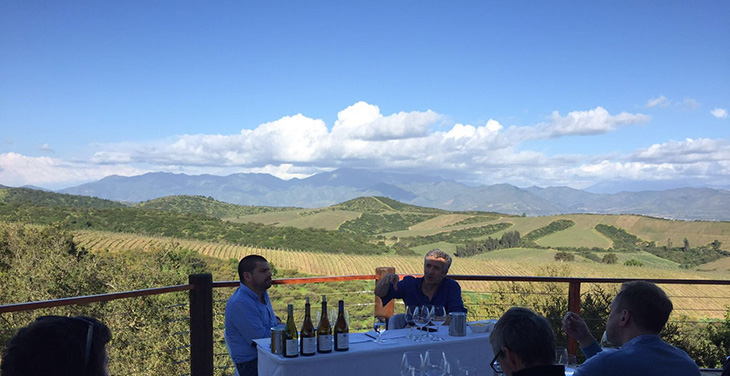
Eduardo Chadwick (right) taking us through the range of his Aconcagua Costa wines.
|
Upon our arrival at Santiago airport, we were driven through the Casablanca valley to the coastal city of Viña del Mar. Although this seaside resort was a picturesque place to stay the night, the real reason we were here was because of its proximity to the Aconcagua valley. The valley (named after the highest peak in the western hemisphere) extends all the way from the Pacific coast to the foothills of the Andes. As such, it offers a variety of different microclimates that become warmer the further inland you travel. It is no wonder that Eduardo has three of his four main estates located here.
After a quick lunch overlooking the Pacific Ocean, we were driven to Errazuriz’s Aconcagua Costa estate, 11km from the ocean at the entrance to the valley. The proximity to the Pacific Ocean (whose Humboldt Current provides a year-round cooling influence) has the potential to produce cool climate wines of impeccable freshness and balance. After a quick walk through the undulating vineyards (reminiscent of Piedmont), we hiked to the top of a hill to taste the estate’s wines in an open air tasting room with a 360 degree view of the vines.
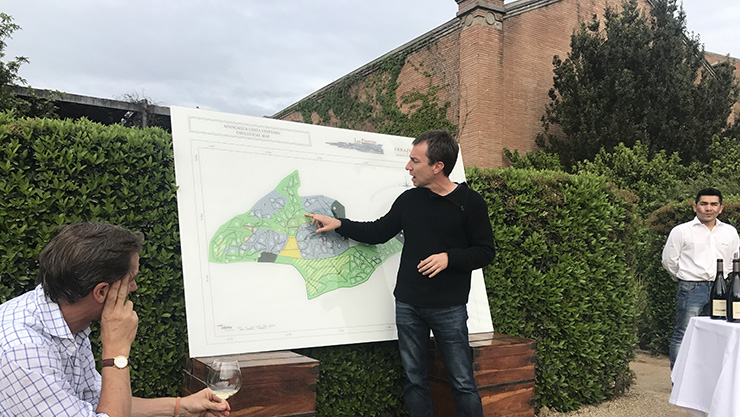
Winemaker Francisco Baettig explaining the intricate parcel selection for the Las Pizarras wines.
|
The standouts for me were Las Pizarras Chardonnay 2016 and Las Pizarras Pinot Noir 2016, both made from specially selected parcels within the estate. Las Pizarras means ‘slate’ in Spanish and, thanks to the eponymous soil, they exhibit the complexity and minerality that you might more commonly associate with Burgundy than with the New World. I was not surprised to learn that the winemaker, Francisco Baettig, is constantly aiming to improve these wines with advice from, and by working alongside, some of the biggest names in Burgundy.
The following morning we were back in the Aconcagua valley but this time much further inland (41km) to the hillside vineyards of Viña Seña. Seña was established in 1995 as a joint venture between Viña Errazuriz and Robert Mondavi but, since 2005, Eduardo has assumed full control. Seña (which means ‘signature’ in Spanish) is a biodynamically-grown, Bordeaux-style blend that has become an iconic wine. At ‘The Berlin Tasting’ in 2004, Seña beat the likes of Châteaux Lafite, Latour and Margaux in a blind tasting that has become Chile’s equivalent of ‘The Judgement of Paris’.
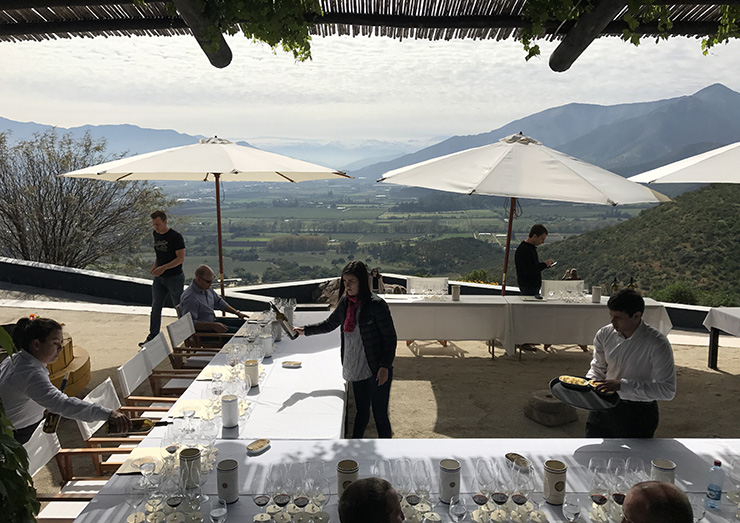
Getting ready for a vertical tasting of Viña Seña.
|
After a vineyard tour, where we learnt about the specific soil composition and their extensive biodynamic methods, we were driven to a mirador (‘lookout’) at the highest point of the estate. The view from the terrace was breath-taking – the vines below blending into the surrounds of the lush, green valley that was framed by the snow-covered Andes in the distance. It reminded me a lot of Central Otago in New Zealand’s South Island. However, our attention quickly turned to a vertical tasting of Seña from 1996 through to 2015.
It was clear to see real vintage variation between the cooler and warmer years and we unanimously preferred the finesse and elegance of the cooler vintages. Over time, thanks to a combination of vine age and a trust in their terroir, they have pared back the ripeness and alcohol to produce a well-balanced and sophisticated wine that can rival those made in the Médoc. The standout was the 2015 which I think is a world class wine that fully deserves its 100 point score from James Suckling.

The breath-taking view from the mirador at Viña Seña.
|
After a light lunch, where we were able to enjoy a glass of Seña with the meal (I opted for the delicious 2000), we drove to the Don Maximiano estate and winery, even further inland (66km) at Panquehue. Don Maximiano Errazuriz planted the first French grape varieties in the Aconcagua valley in 1870 and the original winery survives to this day, despite being damaged by earthquakes. It has been joined by a state-of-the-art, modern winery that wouldn’t look out of place in Bordeaux or Napa.
We learnt more about the famous Berlin Tasting which, far from being a one-off, was replicated 19 times around the world from Los Angeles to Tokyo. Ten years and 22 blind tastings later, and with consistent results, it was clear that Chilean wines could compete with the very best from Bordeaux and Tuscany. We descended into the ancient barrel cellars to do a vertical tasting of Don Maximiano Founder’s Reserve from 1983 through to 2015. Over the years, the blend has changed from 100% Cabernet Sauvignon to Cabernet-dominant with some Carmenère – the long lost Bordeaux variety that now calls Chile home. While I particularly enjoyed the mature but sweet 1993, it was clear to see this wine has really stepped up a notch since the turn of the decade.

Eduardo proudly explaining how Chilean wine took on the world and won in Berlin in 2004.
|
After the tasting, we inspected the new winery which reminded me of the architectural stylings of Châteaux Cheval Blanc’s and Cos d’Estournel’s new wineries. I’m pleased to report all of the original winery and buildings are very much still in use too. To build up our appetite before dinner, we walked to the top of a hill overlooking the vineyards to get a panoramic view of the Don Maximiano estate. When we returned to the winery we were greeted with the sight (and smell) of lamb being cooked on a BBQ while king crab boiled over an open fire. After this delicious dinner, we climbed back on to the bus for the long drive back to Santiago where we would be staying the night.
The next morning, as we left our hotel in the modern business district of Las Condes and drove south to Viñedo Chadwick in the Maipo valley, we had the dramatic backdrop of the snow-covered Andes on our left-hand side. The urban sprawl of Santiago has encroached on the historic vineyards of the Maipo valley and the area looked a lot like Pessac-Léognan with vineyards surrounded by the city. Eduardo’s father, Alfonso Chadwick Errazuriz, was an accomplished polo player and the field where he once played is now planted with vines that make the wine named in his honour.
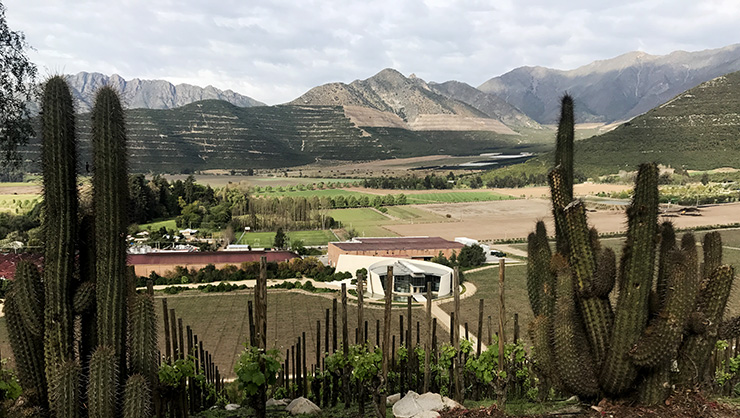
The historic Don Maximiano estate with the modern winery in the foreground.
|
Don Alfonso (who once played alongside Prince Philip) captained the Chilean polo team that famously beat the Argentinians. Eduardo proudly stated “Argentina is better at polo – but Chile makes better wine”. It was here that we learnt what makes Chile so unique for producing fine wine. Although located on the 33rd parallel, effectively giving it a Mediterranean climate, the cooling influence of both the Humboldt Current and the winds coming off Andes means that the vineyards surrounding Santiago have greater diurnal variation than both Tuscany and Bordeaux (located at 43° and 44°, respectively).
We then sat down for our third and final vertical tasting of the trip, where we experienced vintages of Viñedo Chadwick – made from 100% Cabernet Sauvignon – from 1999 to 2015 (including Chile’s first ever 100 point wine, the 2014). While there was nothing to set 2014 and 2015 apart qualitatively I much preferred the richness of the 2015. After the tasting we sat down for lunch on the lawn of the old family home where we were served a very special wine indeed, Viñedo Chadwick 2000 – the wine which took first place in the inaugural Berlin Tasting and forever cemented Chilean wine’s place on the world map. A fitting way to finish a memorable trip.

The vineyards at Viñedo Chadwick with the snow-covered Andes in the distance.
|
On the way back to the airport and, indeed, on the 14 hour direct flight back to London, I had plenty of time to reflect on the trip and what I had learnt in my short but sweet stay. Chile is a breathtakingly beautiful country, similar to New Zealand in many ways – stunning scenery, friendly people, delicious food and, in Eduardo’s case, the drive and passion to make great wines.
As the fifth largest exporter, and the seventh largest producer, of wine in the world, Chile has often suffered from a reputation for producing quantity over quality. However, from this trip, it is clear that a small number of producers are making the most of the unique terroirs to make world class wines that can compete with the best from Bordeaux and beyond. To ignore them is to our detriment. Eduardo Chadwick’s vision, coupled with Francisco Baettig’s technical skills should ensure that the future of fine wine in Chile is in very good hands indeed.
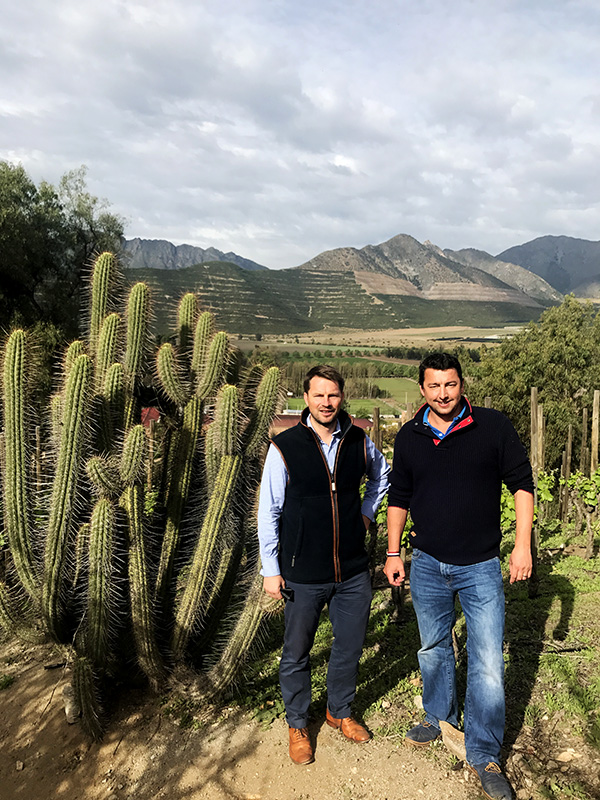
Roving reporters Alastair and Ed coming to you live from the Aconcagua valley.
|